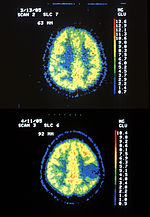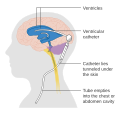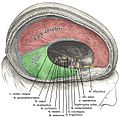 | Cerebral edema is excess accumulation of fluid (edema) in the intracellular or extracellular spaces of the brain. This typically causes impaired nerve... 70 KB (7,826 words) - 10:07, 13 April 2024 |
 | arise via tumor compression (e.g. pinealoblastoma), or through cyclical gliosis secondary to an initial partial obstruction. The cerebral aqueduct was... 4 KB (401 words) - 16:32, 18 February 2024 |
 | Cavernous hemangioma (redirect from Cerebral cavernous malformations) brain is called a cerebral cavernous malformation or CCM. Despite its designation as a hemangioma, a cavernous hemangioma is not a tumor as it does not display... 33 KB (3,660 words) - 05:58, 8 April 2024 |
Intracerebral hemorrhage (redirect from Cerebral haemorrhage) brain, such as cerebral arteriolosclerosis, cerebral amyloid angiopathy, cerebral arteriovenous malformation, brain trauma, brain tumors and an intracranial... 43 KB (4,483 words) - 18:19, 15 April 2024 |
 | Intracranial aneurysm (redirect from Cerebral Aneurysms) intracranial aneurysm, also known as a cerebral aneurysm, is a cerebrovascular disorder in which weakness in the wall of a cerebral artery or vein causes a localized... 35 KB (3,736 words) - 05:18, 19 March 2024 |
Cerebral salt-wasting syndrome (CSWS), also written cerebral salt wasting syndrome, is a rare endocrine condition featuring a low blood sodium concentration... 9 KB (879 words) - 22:02, 12 June 2022 |
 | Hypoxia (medicine) (section Cerebral hypoxia) eating disorders and cerebral palsy. Tumor hypoxia is the situation where tumor cells have been deprived of oxygen. As a tumor grows, it rapidly outgrows... 106 KB (11,537 words) - 04:44, 5 April 2024 |
 | Glioblastoma (category Brain tumor) GBMs usually form in the cerebral white matter, grow quickly, and can become very large before producing symptoms. The tumor may extend into the meninges... 79 KB (8,527 words) - 18:04, 29 April 2024 |
 | Meningioma (redirect from Meningioma brain tumor) Meningioma, also known as meningeal tumor, is typically a slow-growing tumor that forms from the meninges, the membranous layers surrounding the brain... 41 KB (4,201 words) - 07:23, 5 April 2024 |
 | Astrocytoma (category Brain tumor) Astrocytoma is a type of brain tumor. Astrocytomas (also astrocytomata) originate from a specific kind of star-shaped glial cell in the cerebrum called... 22 KB (1,948 words) - 11:05, 4 April 2024 |
 | A cerebral shunt is a device permanently implanted inside the head and body to drain excess fluid away from the brain. They are commonly used to treat... 30 KB (3,099 words) - 03:32, 3 December 2023 |
Perez, Denise (2020), [Video] "Tengo un tumor cerebral", revela Ana María Alvarado [[Video] "I have a brain tumor," reveals Ana María Alvarado], web: El... 9 KB (769 words) - 06:54, 27 March 2024 |
 | Brain ischemia (redirect from Cerebral ischaemia) demand. This leads to poor oxygen supply or cerebral hypoxia and thus leads to the death of brain tissue or cerebral infarction/ischemic stroke. It is a sub-type... 21 KB (2,308 words) - 01:59, 18 March 2024 |
 | Falx cerebri (redirect from Cerebral falx) tends to grow predominantly into one cerebral hemisphere but is often bilateral, and in some patients the tumor grows into the inferior edge of the sagittal... 8 KB (927 words) - 16:17, 18 January 2024 |
brain tumors. Cerebral blood volume is one of the parameters that is assessed with CT perfusion, often as part of Ischemic stroke evaluation. Cerebral blood... 13 KB (1,563 words) - 21:01, 17 August 2023 |
 | Brain metastasis (redirect from Cerebral metastasis) another location in the body and is therefore considered a secondary brain tumor. The metastasis typically shares a cancer cell type with the original site... 29 KB (2,967 words) - 19:02, 26 March 2024 |
2018). "El hijo de Carlos Menem y Cecilia Bolocco será operado de un tumor cerebral". BBC News Mundo (in Spanish). Retrieved 23 May 2020. Caraballo, Harry... 206 KB (11,997 words) - 18:14, 15 April 2024 |
Infarctions, tumors, multiple sclerosis, trauma, encephalitis, migraines, and seizures have been reported to cause cerebral polyopia. Cerebral polyopia has... 13 KB (1,646 words) - 03:19, 23 July 2023 |
 | Lobes of the brain (redirect from Cerebral lobes) The lobes of the brain are the major identifiable zones of the human cerebral cortex, and they comprise the surface of each hemisphere of the cerebrum... 15 KB (1,722 words) - 17:31, 23 February 2024 |
 | Pituitary adenoma (redirect from Pituitary tumor) Pituitary adenomas are tumors that occur in the pituitary gland. Most pituitary tumors are benign, approximately 35% are invasive and just 0.1% to 0.2%... 55 KB (5,762 words) - 13:11, 9 January 2024 |
 | Gliomatosis cerebri (category Brain tumor) growth pattern of some brain tumors, impacting at least three cerebral lobes, mostly with bilateral involvement of the cerebral hemispheres. It can be seen... 4 KB (356 words) - 07:43, 11 March 2024 |
 | Pilocytic astrocytoma (category Brain tumor) area where astrocytes are present, including the cerebral hemispheres and the spinal cord. These tumors are usually slow growing and benign, corresponding... 13 KB (1,332 words) - 08:11, 22 October 2023 |
Transient ischemic attack (redirect from Transient cerebral ischaemic attack) TIA is caused by a temporary disruption in blood flow to the brain, or cerebral blood flow (CBF). The primary difference between a major stroke and the... 46 KB (5,110 words) - 00:20, 30 January 2024 |







